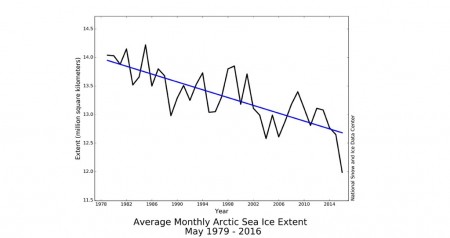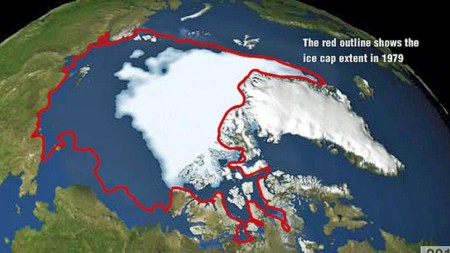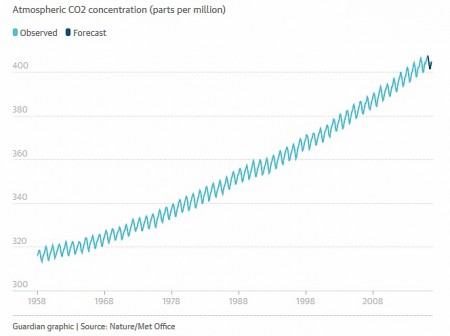June 17, 2016 – According to the latest data from the atmospheric observatory on Mauna Loa we can say goodbye to carbon dioxide (CO2) levels below 400 parts per million (ppm) for the remainder of this century. The graph below is the first of two that tell the story of what human activity combined with cyclical weather events is doing to CO2 concentrations in the atmosphere.
How do we know that these levels won’t come down as we convert from carbon-based energy to renewables? Because of latency. The CO2 levels registering today have yet to take into account additional volumes of the gas being pumped into the atmosphere annually through human activity. So the concentration of CO2 will continue to climb for the foreseeable future and only stabilize at 450 ppm if we cut human emissions by as much as 70% by 2050. It is looking more likely that based on current CO2 production volumes that 450 ppm could be reached in two decades. That’s not so far fetched when you consider between 1986 and the present we have seen a rise of nearly 50 ppm.
If you are questioning the validity of these results or think that Mauna Loa readings do not reflect global distribution of atmospheric CO2 you’ll be disappointed to find out that the data is at the low end of what has actually been recorded as a mean global average. In May 2016 the mean concentration of atmospheric CO2 reached 407.7 ppm.
The second graph to note tracks the extent of Arctic Sea Ice which appears to be trending downward in what one report described as a “death spiral.” Seen below it shows as of May 2016 that sea ice in the Arctic Ocean was 600,000 square kilometers (232,000 square miles) less than in any previous year since satellites started their observations beginning 38 years ago.

The latest data includes new record temperatures being recorded for the Arctic Ocean at 4 to 5 Celsius (7 to 9 Fahrenheit) above 1981 to 2010 averages. This confirms what scientists have always predicted, that global warming’s impact on the northern pole will happen twice as fast as anywhere else on the planet. Why? Arctic Amplification, a process caused by several factors:
- decline in reflective ice and snow layers leads to land absorbing more of the Sun’s heat.
- more open water presents a dark surface which is more heat absorptive than ice.
- dark snow caused by atmospheric pollution from the burning of fossil fuels accelerates surface melt.
And “what happens in the Arctic doesn’t stay in the Arctic” as we here in North America are finding out. The behaviour of high pressure systems and the Jet Stream reflects the changes to Arctic climate conditions. This is creating all kinds of new weather patterns over North America: drought and wildfires (think Fort McMurray) in the western half of the continent, new tornado patterns across the U.S. Midwest, and highly variable weather conditions across much of the east as cold fronts and warmer ocean fronts collide. In Toronto in the last two weeks we have had temperatures normally more common to early May than the beginning of June while back in March we had May-like weather and in April weather that was more like November. In other words, weather that was all over the map. And when you look at the behaviour of the Jet Stream and its uncharacteristic wavy appearance you begin to understand just how much “normal” is changing.
As Jennifer Francis, a Professor at Rutgers University and a leading expert on Arctic Amplification explains: “Amplified Arctic warming and sea-ice loss favor the formation of blocking high pressure features in the North Atlantic. These blocks can cause all sorts of trouble, including additional surface melt on Greenland’s ice sheet (the primary focus of this study) as well as persistent weather patterns both upstream (North America) and downstream (Europe) of the block.”
Nowhere more than on Greenland is climate change noticeable. And some on the island welcome what is going on.
Throughout much of its history the name Greenland has been a misnomer. Erik the Red, the Viking adventurer, may have called it green to attract settlers to join him after his exile from Iceland. And at that time it may have been greener because the settlements erected coincided with the Medieval Warming period. But today Greenland is not so green.
This is about to change states Danish biologist, Jens-Christian Svenning, who states that the island “has the potential to become a lot greener.” In fact so green that Greenland’s head of government is talking about a population explosion and the opening up of new mines and tourism opportunities. Cruise ships this summer are stopping at Nuuk, the island’s capital, in numbers never seen before. The island’s has contributed over the last decade more than 2 trillion tons of meltwater to the North Atlantic. The exposed land is yielding hidden mineral resources. Forests and tree species common to Alaska and northern Canada can now grow on Greenland.
The worst case climate change scenario may never happen, but if it did consider this. Greenland’s ice mass is three times larger than Texas. If it all melts it raises global sea levels by 6 meters (20 feet). The freshwater entering the Atlantic alters the Gulf Stream and North Atlantic Drift. This changes the ecology of the North Atlantic with impacts on all species. For Greenland climate scientists and glaciologists watching the rivers of ice accelerate to the sea these threats are real, and those on the receiving end of the melt will be people living in low-lying coastal areas around the world.










